| Jan. |
|
Phaius flavus
Orchidaceae
Makino Botanical Garden, Kochi-city, Kochi Pref.
It used to grow naturally from Honshu to Shikoku, Kyushu and Okinawa. Because
of their bright colors and lustrous appearance, they are collected and
looted for horticulture, and their numbers are declining sharply. It is
now rarely seen in the wild. This is grown from wild species.
|
| Feb. |
|
Platanthera boninensis
Orchidaceae
Chichi-jima island, Ogaswara village, Tokyo
The Ogasawara Islands, which are solitary islands about 1000 km away from
the mainland Japan, are a treasure trove of endemic species. Since it was
once called a no-man's island (Munin Island), there are many plants with
the name musin xxx (bonin-xxx in scientific name). The origin of the Japanese
name comes from how a heron flies along.
|
| Mar. |
|
Fritillaria japonica
Liliaceae
Mt. Fujiwara, Inabe-city, Mie Prefecture
There are 9 species of the genus Fritillaria in Japan, which are endemic to Japan, including uncertified species, and 6 of them are designated as endangered species. They are spring ephemerals that bloom in early spring and quietly return to the ground when the surrounding trees spread their leaves.
|
| Apr. |
|
Rhododendron latoucheae
Ericaceae
Iriomote Island, Taketomi Town, Okinawa Pref.
An intermediate type between rhododendrons and azaleas and is distributed
on Ishigaki Island and Iriomote Island. It is difficult to find its own
habitat, so it is said to be a phantom flower. I saw this flower on the
bank of the Urauchi River. It has a deep pink color and is also known as
"Xishi flower" after the beautiful woman Xishi in the ancient
era (Spring and Autumn period) of China.
|
| May |
|
Lilium japonicum var. abeanum
Liliaceae
Naka-town, Tokushima Pref.
It is slightly smaller than the Sasayuri which is endemic and distributed on the serpentine ground in western Japan, but the color of the flower is deeper, and it is said to be the most beautiful among the lilies in Japan. Because it was collected for the first time in Jinryo-cho, Tokushima Prefecture, it was given this name.
|
| Jun. |
|
Lilium speciosum Thunb. var. clivorum
Liliaceae
Tosayam, Kochi-city, Kochi Pref.
This is a variant of brilliant lily (Lilium speciosum) which is endmic
of Japan. It blooms like it hangs down from cliffs and slopes, so that
the name Taki (cliff) can be applied to it. By the way, brilliant lilies
stand upright.
|
| Jul. |
|
Meconopsis regia
Papaveraceae
Jamjung Himal, Nepal
A large-type blue poppy distributed in Lamjung Himal in central Nepal.
It is very similar to M. paniculata of the same genus, but can be distinguished by the greenish-yellow tip of the pistil (style). Regia means "King". It is the king of the blue poppies. So, what about the Queen?
|
| Aug. |
|
Meconopsis simikotensis
Papaveraceae
Simikot, Humla district, Nepal
A blue poppy that blooms in the Humla district, the westernmost part of Nepal. It belongs to the subgenus Discogyne, which has a disc-shaped tip, and its members are found in Bhutan and Tibet as well as Nepal. It blooms on the mountains along the pilgrimage route to Kailash.
|
| č„Ćé |
|
Gentiana nipponica var. robusta
Gentianaceae
Mt. Iide, Kitakata-city, Fukushima Pref.
A variant of Gentiana nipponica and endemic of Mt. Iide. The difference
from Gentiana nipponica is that the corolla segments of this species stand
upright during flowering and cover the throat to protect the pollen from
rain. Rishiri Gentian (Rishiri Rindo) from Hokkaido is a close kin.
|
| Oct. |
|
Habenaria dentata
Orchidaceae
Makino Botanical Garden, Kochi-city, Kochi Pref.
This name was given because it is taller than egret flower (Pecteilis radiata)
which is the symbol flower of my town, Setagaya Ward.
Egret flowe has fine slits in the petals, but this species does not and
the genus is different. They used to be seen along footpaths in mountainous
areas, but their numbers have drastically decreased due to looting.
|
| Nov. |
|
Leucosceptrum stellipilum
Lamiaceae
Mt. Takakuma, Tarumizu-city, Kagoshima Pref.
Most of Labiatae are grasses (herbs), but only this species has woody stems.
The reddish-purple flowers are attached to spikes and bloom from the bottom.
This Japanese name "Mikaeri sou (meaning looking back)" comes
from the fact that you can't help but look back at the beauty of the flowers.
Another name for this plant is Itokakeso (meaning thread handing).
|
| Dec. |
|
Orostachys japonica
Crassulaceae
Kanka-valley, Showdoshima-town, Kagawa Pref.
A succulent plant growing on the dry rock field. The shape of the rosette
leaves at the bottom is likened to the lotus seat where Buddha sits, and
the pointed tip of the leaf is likened to a nail, hence the name. Red anthers
stick out from the small white flowers on the stem. |
| Back cover |
|
Tricyrtis ishiiana var. surugensis
Liliaceae
Mt. Kenashi, Fujinomiya-city, Shizuoka Pref.
There are five species of Tricyrtis family in Japan and all are endangered
species. They inhabit wet rocky areas facing north. This species is considered
to be a variant of Sagami Jorou Hototogisu (Tricyrtis ishiiana) that blooms
in Mt. Tanzawa . The famout botanist Tomitaro Makino, who collected it
at Mt. Yokokura in Ochi-cho, Kochi Prefecture, where is close to his home
town, named it because it represents the elegance of ancient court ladies
in Heian era
|
_thumb.jpg)
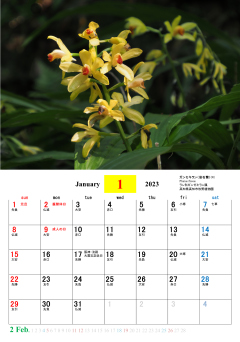
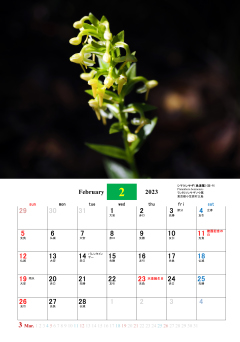
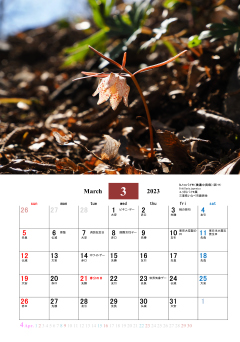
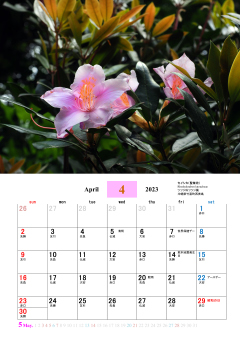
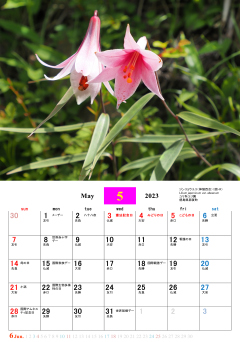
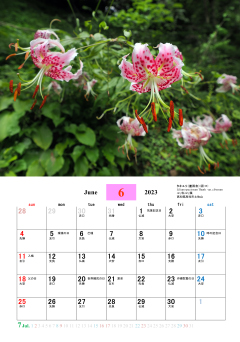
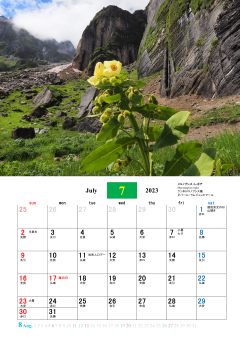
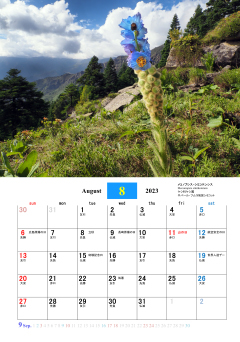
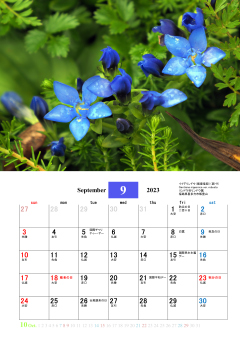
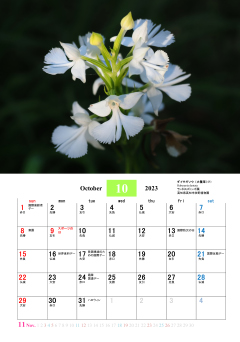
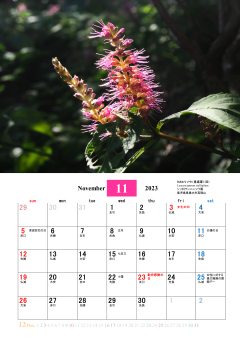
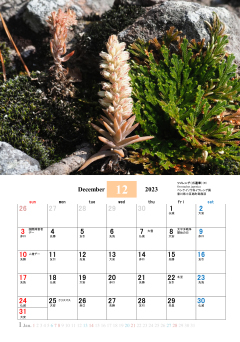
_thumb.jpg)